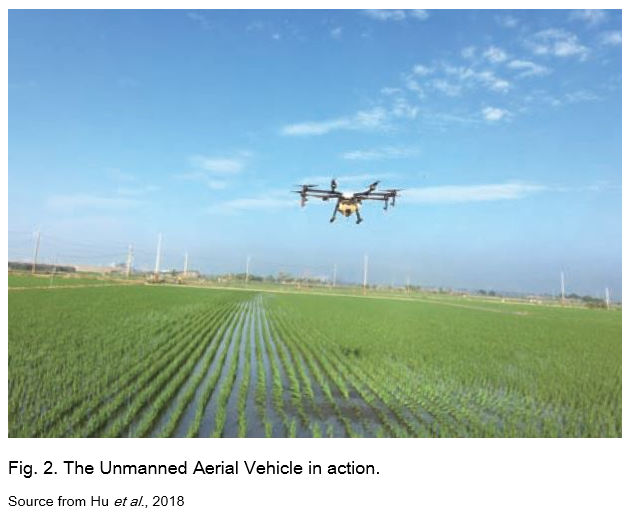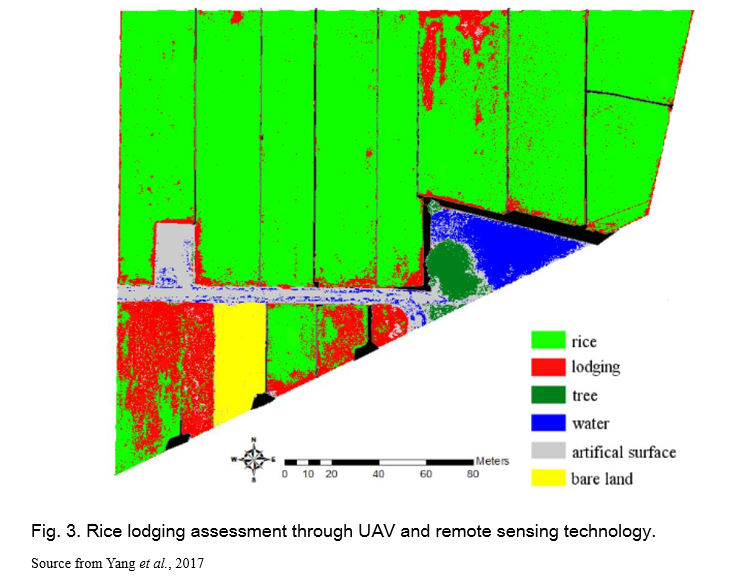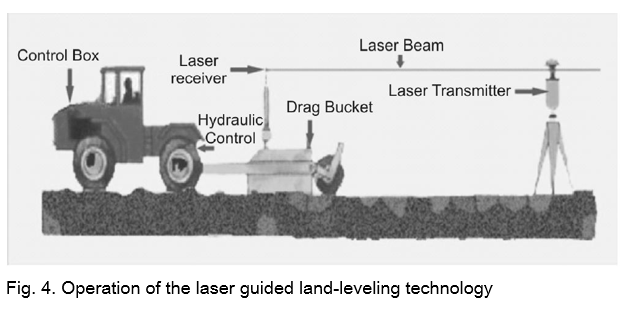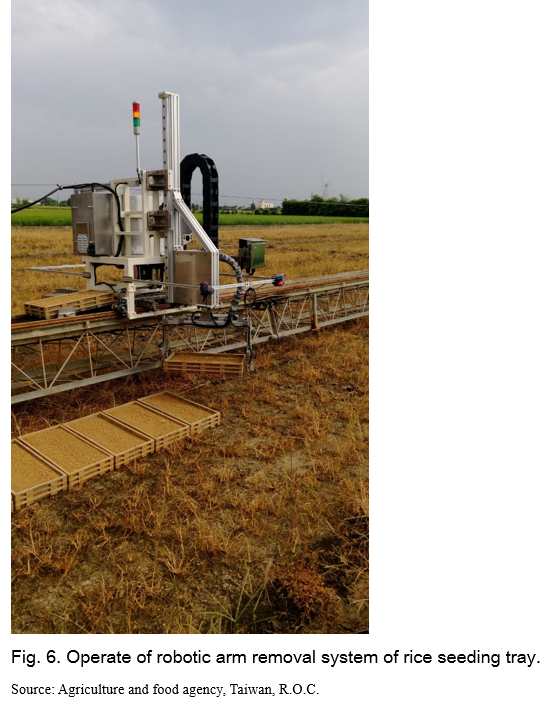ABSTRACT
Precision agriculture is known as site-specific farming or sustainable-land-use low-input farming, which is used to reduce fertilized and chemical pesticides by variable-rate operating system. For the Asian and Pacific region, there are two problems concerning precision agriculture. One is small scale farming, and the other is input of technology. In Taiwan, majority of the research focuses on water conservation and reduction of labor forces requirement. Laser guided land-leveling can save up to 25% of water consumption. Rice seeding tray robotic arm removal system can reduce 28% of labor forces requirement. The development of precision agricultural technology has achieved many results. However, in terms of promotion, there is still a need to consider the improvement of economic efficiency to attract more farmers to use these technologies.
Keywords: Precision Agriculture, Rice.
INTRODUCTION
Precision agriculture (PA) began in the United States in the 1990s where more than 93% of farms use PA. In 2013, data shows that the annual output value of US farms using PA is more than one million U.S. dollars. PA is known as site-specific farming or sustainable-land-use low-input farming. It is a combination of several technologies such as global positioning system (GPS), remote sensing technology (RS), and geographic information system (GIS) that collects data of growth traits, and yield of fields, and carries out various kinds of management. In countries like Australia and Italy, data shows that there is a 10%-15% increase in yield while at the same time, maintaining the quality of the environment (Fig. 1).

However, the condition of farm cultivation in the Asian and Pacific region still needs a lot of improvement. There are less arable lands and, coupled with the ageing farmer population, agricultural productivity is affected. Moreover, farmers have to contend with using small machines making specific data gathering difficult and field farm management less efficient. Different scales of technology levels will reflect different kinds of precision agriculture (Table 1). This article introduces four machines in Taiwan. They are the Unmanned Aerial Vehicle (UAV), laser guided land-leveling, robotic arm removal system of rice seeding tray, and intelligent sluice gate.
Table 1. Prospects of scale-dependent main technology required for precision farming
|
Management
Scale (ha)
|
Positioning for operations
|
Soil mapping in a field
|
Yield mapping within a field
|
Variable-rate control
|
|
-1
|
Empirical determination and intuition
|
Average for each field
|
Average for each field
|
Manual control with a monitor
|
|
1-10
|
Automatic field-based survey or machine positioning
|
Variability within a field determined by soil sensors
|
Variability within a field determined by yield monitor
|
Operator’s skill with monitoring and automated machinery
|
|
10-50
|
GPS-oriented + field-based machine positioning
|
Variability within a field determined by GPS-based sensors + remote sensing
|
Variability within a field determined by GPS-based sensors + remote sensing
|
Sensor-based variable-rate control with GPS/GIS
|
|
50-
|
GPS-oriented + field-based machine positioning
|
Within/regional field variability determined by GPS-oriented sensors + remote sensing
|
Within/regional field variability determined by GPS-oriented monitor + remote sensing
|
Sensor-based variable-rate control with GPS/GIS
|
Source from Sasao and Shibusawa, 2000
FOUR MACHINES AS PART OF TAIWAN’s PRECISION AGRICULTURE
Different scales of farms will reflect different kinds of machines for precision agriculture. From airplane seeding in the USA to auto rice transplanting machines in Japan, agricultural machines are constantly modified to help in farm operations. In Taiwan, there are four kinds of machines that form part of precision agriculture in rice farming. They are currently being promoted and their market acceptance are still being observed and studied.
Unmanned Aerial Vehicle
The traditional forms of spraying in paddy fields pose several problems and difficulties for farmers. The movement of farmers while spraying is one of them. There is also the issue of transmission of disease especially when chemical pesticides and fertilizers are concerned, threatening the health of farmers. The UAV spraying system (Fig. 2) uses remote control, GPS positioning and automatic route planning.

Depending on different pesticide types, it was shown that use of UAV to spray pesticides can save about 80% of operating time, 90% of water consumption and 50% of pesticide use. The money spent by farmers from outsourcing their spraying operation is about $85-$100 dollars per hectare, almost the same as in traditional spraying. Limited by weight bearing capacity, fertilizer application could be sprayed by knapsack power sprayer. On the other hand, UAV, remote sensing technology, and GIS have been tried and continue to be utilized in agriculture disaster assessment in Taiwan. (Fig. 3)

Laser guided land-leveling
The different kinds of soil levels in farm fields leads to a lot of irrigation water wastage, uneven distribution of fertilizer and can further cause the spread of pests and diseases in the farm. The laser leveling technology (LGL) (Fig. 4) uses laser transmitter that emits parallel beam to survey and evaluate the soil level in the field. The beam is received by a laser receiver that automatically adjusts the drag bucket to level the field. In India, this technology has benefited the farmers by reducing the labor requirement for irrigation, and at the same time, increase the water application efficiency up to 50%, thereby improving the crop yield by up to 10-15%. Data shows the rice plants are significantly growing using the LGL technology in the Punjab area. (Fig. 5).


In Taiwan, the LGL technology has shown that after leveling of the land, the plants’ height difference can be reduced from 10.7 cm to 3.6 cm in the area of 0.5 hectares. Also, water used for irrigation is also reduced to about 25%. However, the whole operation takes more than 6-8 times compared to the traditional method, so the outsourcing farming team has expressed no intention to use LGL.
Robotic arm removal system of rice seeding tray
In the rice cultivation process, most of the labor cost is spent in rice seeding.
Workers need to carry several tons of seedling trays every day. In order to address this problem, in 2018, a technology known as the Robotic arm removal system (Fig. 6) has been introduced to the public in Taiwan. The technology uses a servo motor to position and control the system. Servo motor matches with servo electric cylinder to control the gripper for picking up and unloading the seedling tray. In Taiwan, this technology has shown the capability to remove 830 seeding trays per hour, which can actually save about 28% of labor cost. The machine weighs about 150 kg, and can be loaded on the conveyor belt without adding extra equipment. This technology can also address the issue of ageing farmer population and could motivate farm organizations to invest in such kinds of machines in the future.

Intelligent sluice gate system
The government support farmer to lease farmland from leaving or aged farmers in Taiwan. Because of farmland fragmentation, there is far distance between leased fields. The management of irrigate and irrigation depth will waste lots of labors. Intelligent sluice gate system is including of intelligent sluice gate, sensor, and management server. It uses sensor setting in the field to measure irrigation depth and send reports to management server. Management server can start up intelligent sluice gate by automatic and artificial control. It was shown can save more than 50% labor cost and water used for irrigation is also reduced to about 25% in Taiwan. However, because the cost of amount and price of sensor, the farmers has expressed no intention to use.

CONCLUSION
PA has been proven to enhance the yield of crops, reduce chemical use in production, can help protect the health of farms, save on labor and contribute to the efficient use of water resources. In countries like United States and Australia, PA has been shown to be beneficial ion large-scale farming operations. However, in the Asia-Pacific region, where most of the farm cultivation areas are less than three (3) hectares, the benefits are yet to be truly confirmed. While the development of technology is far ahead many farmers, especially those who are operating on small-scale basis, cannot afford to buy and use these expensive machines. Currently, outsourcing farming teams, production and marketing groups will be the main source of technologies of farmers. On the other hand, the regulation of technologies like the UAV would need education and training for a lot of Asian farmers in the future.
REFERENCES
Di, H., and C. Andi. 2014. Precision agriculture in rice production. (https://static1.squarespace.com/static/5a03c05bd0e62846bc9c79fc/t/5a14be9141920213694cda67/1511308958787/Precision+Agriculture+in+rice+production-grower+experience+and+insights.pdf; Accessed 25 June 2019)
Giuseppe, S., S. Roberto, F. Antonio, and M. Goorgio. 2019. Rice yield advances under precision agriculture: a farm lesson. Journal of Agronomy and Research 1(4):10-21.
Sasao, A., and S. Shibusawa. 2000. Prospects and strategies for precision farming in Japan. Japan Agriculture Research Quarterly 34(4):233-238.
Shiv, K. L., S. S. harminder, and S. Manpreet. 2014. Laser guided land leveling and grading for precision farming. Precision farming: A New Approach:148-158.
Hu, C. C., F. Y. Chang, H. P. Chou, and Y. Y. Wang. 2018. Prospect of unmanned aerial vehicles used in field management of rice. Agriculture News of Kaohsiung DARES 105:26-28.
Yang, C. M., and C. Y. Lin. 2003. Studies on rice precision farming system. Rice Precision Farming System:1-12 Special Publication of TARI No. 105.
Yang, M. D., K. S. Huang, Y. H. Kuo, H. P. Tsai, and L. M. Lin. 2017. Spatial and spectral hybrid image classification for rice lodging assessment through UAV imagery. Remote Sensing 9:583-601.


Overview of Precision Agriculture with Focus on Rice Farming
ABSTRACT
Precision agriculture is known as site-specific farming or sustainable-land-use low-input farming, which is used to reduce fertilized and chemical pesticides by variable-rate operating system. For the Asian and Pacific region, there are two problems concerning precision agriculture. One is small scale farming, and the other is input of technology. In Taiwan, majority of the research focuses on water conservation and reduction of labor forces requirement. Laser guided land-leveling can save up to 25% of water consumption. Rice seeding tray robotic arm removal system can reduce 28% of labor forces requirement. The development of precision agricultural technology has achieved many results. However, in terms of promotion, there is still a need to consider the improvement of economic efficiency to attract more farmers to use these technologies.
Keywords: Precision Agriculture, Rice.
INTRODUCTION
Precision agriculture (PA) began in the United States in the 1990s where more than 93% of farms use PA. In 2013, data shows that the annual output value of US farms using PA is more than one million U.S. dollars. PA is known as site-specific farming or sustainable-land-use low-input farming. It is a combination of several technologies such as global positioning system (GPS), remote sensing technology (RS), and geographic information system (GIS) that collects data of growth traits, and yield of fields, and carries out various kinds of management. In countries like Australia and Italy, data shows that there is a 10%-15% increase in yield while at the same time, maintaining the quality of the environment (Fig. 1).
However, the condition of farm cultivation in the Asian and Pacific region still needs a lot of improvement. There are less arable lands and, coupled with the ageing farmer population, agricultural productivity is affected. Moreover, farmers have to contend with using small machines making specific data gathering difficult and field farm management less efficient. Different scales of technology levels will reflect different kinds of precision agriculture (Table 1). This article introduces four machines in Taiwan. They are the Unmanned Aerial Vehicle (UAV), laser guided land-leveling, robotic arm removal system of rice seeding tray, and intelligent sluice gate.
Table 1. Prospects of scale-dependent main technology required for precision farming
Management
Scale (ha)
Positioning for operations
Soil mapping in a field
Yield mapping within a field
Variable-rate control
-1
Empirical determination and intuition
Average for each field
Average for each field
Manual control with a monitor
1-10
Automatic field-based survey or machine positioning
Variability within a field determined by soil sensors
Variability within a field determined by yield monitor
Operator’s skill with monitoring and automated machinery
10-50
GPS-oriented + field-based machine positioning
Variability within a field determined by GPS-based sensors + remote sensing
Variability within a field determined by GPS-based sensors + remote sensing
Sensor-based variable-rate control with GPS/GIS
50-
GPS-oriented + field-based machine positioning
Within/regional field variability determined by GPS-oriented sensors + remote sensing
Within/regional field variability determined by GPS-oriented monitor + remote sensing
Sensor-based variable-rate control with GPS/GIS
Source from Sasao and Shibusawa, 2000
FOUR MACHINES AS PART OF TAIWAN’s PRECISION AGRICULTURE
Different scales of farms will reflect different kinds of machines for precision agriculture. From airplane seeding in the USA to auto rice transplanting machines in Japan, agricultural machines are constantly modified to help in farm operations. In Taiwan, there are four kinds of machines that form part of precision agriculture in rice farming. They are currently being promoted and their market acceptance are still being observed and studied.
Unmanned Aerial Vehicle
The traditional forms of spraying in paddy fields pose several problems and difficulties for farmers. The movement of farmers while spraying is one of them. There is also the issue of transmission of disease especially when chemical pesticides and fertilizers are concerned, threatening the health of farmers. The UAV spraying system (Fig. 2) uses remote control, GPS positioning and automatic route planning.
Depending on different pesticide types, it was shown that use of UAV to spray pesticides can save about 80% of operating time, 90% of water consumption and 50% of pesticide use. The money spent by farmers from outsourcing their spraying operation is about $85-$100 dollars per hectare, almost the same as in traditional spraying. Limited by weight bearing capacity, fertilizer application could be sprayed by knapsack power sprayer. On the other hand, UAV, remote sensing technology, and GIS have been tried and continue to be utilized in agriculture disaster assessment in Taiwan. (Fig. 3)
Laser guided land-leveling
The different kinds of soil levels in farm fields leads to a lot of irrigation water wastage, uneven distribution of fertilizer and can further cause the spread of pests and diseases in the farm. The laser leveling technology (LGL) (Fig. 4) uses laser transmitter that emits parallel beam to survey and evaluate the soil level in the field. The beam is received by a laser receiver that automatically adjusts the drag bucket to level the field. In India, this technology has benefited the farmers by reducing the labor requirement for irrigation, and at the same time, increase the water application efficiency up to 50%, thereby improving the crop yield by up to 10-15%. Data shows the rice plants are significantly growing using the LGL technology in the Punjab area. (Fig. 5).
In Taiwan, the LGL technology has shown that after leveling of the land, the plants’ height difference can be reduced from 10.7 cm to 3.6 cm in the area of 0.5 hectares. Also, water used for irrigation is also reduced to about 25%. However, the whole operation takes more than 6-8 times compared to the traditional method, so the outsourcing farming team has expressed no intention to use LGL.
Robotic arm removal system of rice seeding tray
In the rice cultivation process, most of the labor cost is spent in rice seeding.
Workers need to carry several tons of seedling trays every day. In order to address this problem, in 2018, a technology known as the Robotic arm removal system (Fig. 6) has been introduced to the public in Taiwan. The technology uses a servo motor to position and control the system. Servo motor matches with servo electric cylinder to control the gripper for picking up and unloading the seedling tray. In Taiwan, this technology has shown the capability to remove 830 seeding trays per hour, which can actually save about 28% of labor cost. The machine weighs about 150 kg, and can be loaded on the conveyor belt without adding extra equipment. This technology can also address the issue of ageing farmer population and could motivate farm organizations to invest in such kinds of machines in the future.
Intelligent sluice gate system
The government support farmer to lease farmland from leaving or aged farmers in Taiwan. Because of farmland fragmentation, there is far distance between leased fields. The management of irrigate and irrigation depth will waste lots of labors. Intelligent sluice gate system is including of intelligent sluice gate, sensor, and management server. It uses sensor setting in the field to measure irrigation depth and send reports to management server. Management server can start up intelligent sluice gate by automatic and artificial control. It was shown can save more than 50% labor cost and water used for irrigation is also reduced to about 25% in Taiwan. However, because the cost of amount and price of sensor, the farmers has expressed no intention to use.
CONCLUSION
PA has been proven to enhance the yield of crops, reduce chemical use in production, can help protect the health of farms, save on labor and contribute to the efficient use of water resources. In countries like United States and Australia, PA has been shown to be beneficial ion large-scale farming operations. However, in the Asia-Pacific region, where most of the farm cultivation areas are less than three (3) hectares, the benefits are yet to be truly confirmed. While the development of technology is far ahead many farmers, especially those who are operating on small-scale basis, cannot afford to buy and use these expensive machines. Currently, outsourcing farming teams, production and marketing groups will be the main source of technologies of farmers. On the other hand, the regulation of technologies like the UAV would need education and training for a lot of Asian farmers in the future.
REFERENCES
Di, H., and C. Andi. 2014. Precision agriculture in rice production. (https://static1.squarespace.com/static/5a03c05bd0e62846bc9c79fc/t/5a14be9141920213694cda67/1511308958787/Precision+Agriculture+in+rice+production-grower+experience+and+insights.pdf; Accessed 25 June 2019)
Giuseppe, S., S. Roberto, F. Antonio, and M. Goorgio. 2019. Rice yield advances under precision agriculture: a farm lesson. Journal of Agronomy and Research 1(4):10-21.
Sasao, A., and S. Shibusawa. 2000. Prospects and strategies for precision farming in Japan. Japan Agriculture Research Quarterly 34(4):233-238.
Shiv, K. L., S. S. harminder, and S. Manpreet. 2014. Laser guided land leveling and grading for precision farming. Precision farming: A New Approach:148-158.
Hu, C. C., F. Y. Chang, H. P. Chou, and Y. Y. Wang. 2018. Prospect of unmanned aerial vehicles used in field management of rice. Agriculture News of Kaohsiung DARES 105:26-28.
Yang, C. M., and C. Y. Lin. 2003. Studies on rice precision farming system. Rice Precision Farming System:1-12 Special Publication of TARI No. 105.
Yang, M. D., K. S. Huang, Y. H. Kuo, H. P. Tsai, and L. M. Lin. 2017. Spatial and spectral hybrid image classification for rice lodging assessment through UAV imagery. Remote Sensing 9:583-601.